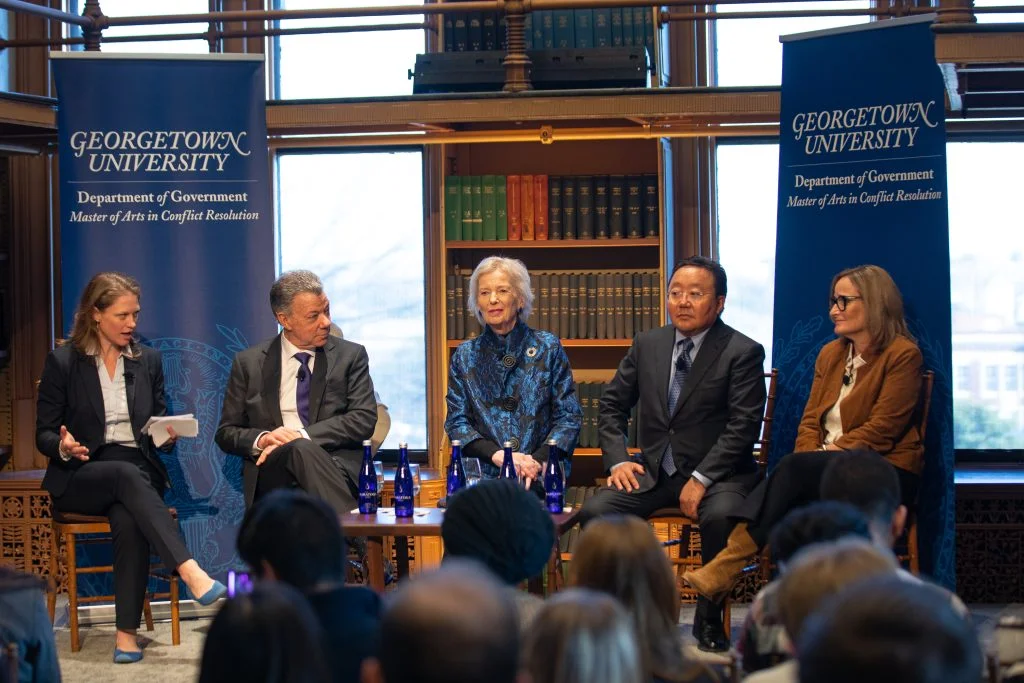Leaders from around the world gathered at Georgetown University on Jan. 24 to discuss the moving of the Doomsday Clock closer to midnight, a physical reflection of the world’s increasing proximity to global catastrophe.
The Bulletin of Atomic Scientists, the organization that leads the Doomsday Clock and promotes awareness of man-made threats to human existence, moved the arrows of the clock on Jan. 24 to just 90 seconds away from midnight, the closest they have ever been to midnight — which represents global destruction — in history. The closest before this year was 100 seconds to midnight.
Mary Robinson, the first female president of Ireland; Elbadorj Tsakhia, the former president and prime minister of Mongolia; Juan Manuel Santos, the former president of Colombia; and Rachel Bronson, the president and CEO of The Bulletin of the Atomic Scientists, gathered at the Jan. 24 Doomsday Clock Town Hall to discuss the global conflicts, including the ongoing war in Ukraine, which are pushing the clock closer to global destruction.

Tsakhia, the youngest member of The Elders, a group of world leaders that Nelson Mandela founded in 2007, said the outcome of the war in Ukraine will be important to the state of global freedom and safety.
“I am always in support of the Ukrainian people because they have a right to exist, they have a right to live freely and they have the right to choose their fate,” Tsakhia said during the event. “And because of that, I think we have to rally behind those who are fighting for global peace and security.”
The moving of the Doomsday Clock arrows started in 1947, when its hands rested seven minutes away from midnight. The Bulletin of the Atomic Scientists also held a town hall after they set the clock at 100 seconds to midnight in January 2020, in part due to the threat of nuclear war and the growing climate crisis.
John Pope, the chief audience officer of The Bulletin of the Atomic Scientists, said all students, regardless of their background, need to make a long-term commitment to preventing the global issues that make the world unsafe.
“The man-made risks covered by the Doomsday Clock affect everyone and cannot be solved by one generation or group,” Pope wrote to The Hoya. “Georgetown students come from all sorts of different backgrounds and are pursuing all sorts of different professional interests. But all of you have the potential to contribute to making the world a safer place.”
Tsakhia said he values opportunities to speak to students about the threats and potential solutions that they will inherit.
“When I talk in front of you, I try to choose my words very carefully because you guys are going to live after me,” Tsakhia said.
In their decision to change the Doomsday Clock, the Bulletin of the Atomic Scientists cited the threat of nuclear war, Russia’s attacks on nuclear reactor sites that could release radioactive materials and disinformation about bioweapons.
While creating peace is important to preventing further violence and victimhood, it sometimes conflicts with justice and accountability, according to Santos.
“It has a price, and the price has to do with justice,” Santos said at the event. “Every single peace process that is resolved on the negotiating table boils down to where you draw the line between peace and justice. How much justice are you as a person — and you as a society, as a country — willing to sacrifice to have peace?”
Even though much of the world has mobilized together to support Ukraine, other countries remain hesitant to oppose Russia and risk their own wellbeing, according to Bronson.
“I think the very fact that the NATO countries have come together in a unified fashion, that the EU has come together on this, is very significant,” Bronson said at the event. “At the same time, we are seeing in a number of countries the desire not to take sides.”
Pope said engaging with young people through events like the town hall is important to stopping current global threats.
“We like to do these student events because of the important role students can play in advocating for the solutions we need now, and because they are going to be the leaders in the future that maintain those solutions and address new problems,” Pope said. “Our hope is that the audience takes away two key lessons. First, the immediacy of these problems. Second, that they can be addressed.”




















